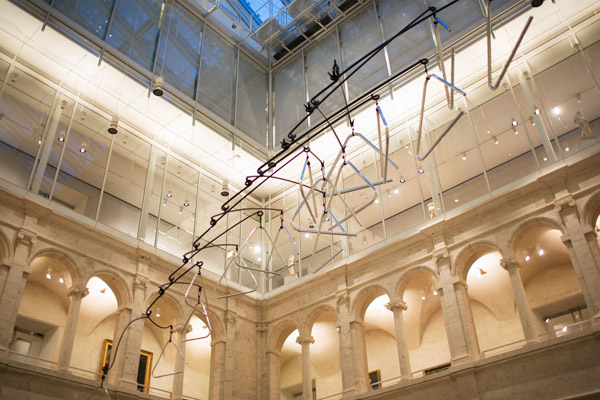A year and a half in the making, Triangle Constellation, by Mexican-born artist Carlos Amorales, was recently installed in the Harvard Art Museums’ Calderwood Courtyard. Amorales first assembled the 556-pound specially commissioned work in Mexico City before shipping it in pieces to Cambridge. It will hang for at least the next several years underneath our glass roof, 32 feet above visitors’ heads.
On the day before installation, we sat down with Amorales and Mary Schneider Enriquez, the museums’ Houghton Associate Curator of Modern and Contemporary Art, to discuss the artist’s creative process and influences. Here’s a condensed version of that conversation.
What inspired Triangle Constellation? Carlos Amorales: The fact that it would be in a new space where the architect literally expanded the building. Also the idea of this being a public sculpture in the courtyard, coexisting with this space that is used for people to walk through or sit in. It’s multifunctional.
There was also another important question: how to make sure this piece won’t be obstructive. It has a sort of transparency; you can look through it at each level to see the collections. . . . Also, the triangles are reflective, and thus reflect the building.
Mary Schneider Enriquez: Carlos came to visit before the building was finished. He visited the space and talked to us at length about how the sculpture would be installed. His work was really a response to trying to unite the building—to see through it, to have it flow, and to connect it to the courtyard, which architect Renzo Piano has talked about as a kind of town square or village center.
Amorales: It’s a response to a very particular place.
Schneider Enriquez: There’s intimacy and monumentality all at once, without overpowering the space. I think it really draws you in. It would have been easy for an artist to create a sculpture that is all about monumentality in this soaring courtyard. Instead, Carlos created something that, because it’s graduated in scale, is very human.
Knowing that this would be a work of art in a public space, what considerations did you make? Amorales: Mostly, I care about a work’s relationship with the public, but on an intellectual level. I don’t think in practical terms about the pieces, but in this case I had to think about it, about how it interacts with the flow of people coming in and out of the building. It was a new challenge in that sense.
Tell us more about the process behind creating the work. Amorales: One key step was to build a model to try to understand the space. I had to build in a similar way to the space, to keep it proportional.
Schneider Enriquez: That’s actually a very important aspect of his process, because not all artists need to construct three-dimensional models in order to realize what they’re heading toward. It’s what gave the work a sense of balance, the whole flow of space that is created by the way these pieces hang and move.
What other influences played a part in how or why you created this work? Amorales: It has a lot to do with a residency I had at Atelier Calder. [The relationship to Alexander Calder’s mobiles] is very much there, and I think people will comment on it. But I also think these are more like instruments—social, musical instruments, because it’s a social group of visitors who can perform with it. Only the lowest triangle is accessible; the others sound, but they are out of reach.
That’s true. And only select people will be able to play, or activate, that lowest triangle, on special occasions. How does the work’s performative identity shape it? Amorales: I like the idea of the contrast from the very simple sound, which comes from that minimal, lowest triangle, to this very large piece as a whole—the opposite proportions.
I think the triangle is one of the simplest instruments you can have. I wanted to use an instrument that everybody can play. If you wanted to have hanging violins, you would need to be a violinist. That’s much more complex. What I like about this is that anybody can make a sound.


